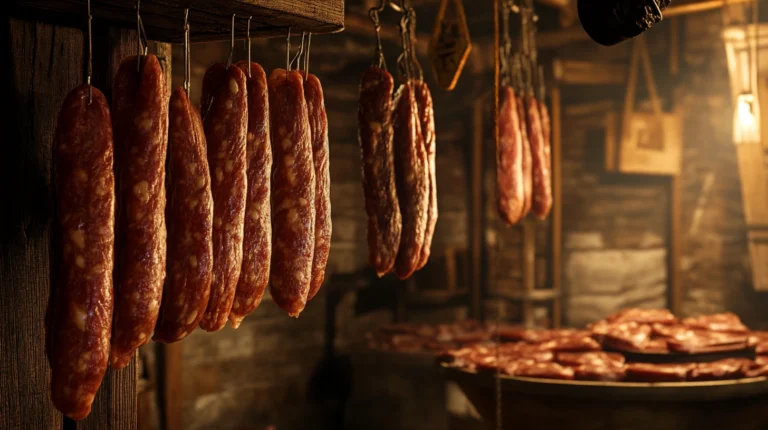Historical Roots and Evolution of Beef Pepperoni
Are you craving a bold, savory cured meat option that you can make at home? Homemade beef pepperoni might be exactly what you need. By controlling your choice of ingredients, seasoning levels, and curing conditions, you can craft a healthier, tastier version than many store-bought alternatives. In this FAQ guide, you’ll discover the essential steps, spices, and timing required to create your very own batch. Moreover, you’ll learn how to tailor the flavor profile to suit your personal preferences—ranging from mildly spicy to extra hot. Whether you’re following a specific dietary plan or simply want a flavorful addition to pizzas, sandwiches, or charcuterie boards, this complete resource on homemade beef pepperoni can help you craft an irresistible, protein-packed treat in the comfort of your own kitchen.
Furthermore, as trade routes expanded, various regions gained access to exotic spices, which directly influenced the seasoning techniques for beef pepperoni. Culinary experimentation flourished, so new approaches to curing and flavoring came into existence. Eventually, a standardized recipe was embraced, particularly in regions with strong cultural or religious preferences for beef over pork. Thus, the evolution of beef pepperoni demonstrates how necessity, commerce, and tradition all converged into a distinct and cherished cured meat.
- Key points in its evolution:
- Adaptation of early spice blends to local ingredients
- Historical preference for beef over pork in specific communities
- Influence of long-distance trade on seasoning techniques
Savor every bite of this homemade beef sausage recipe and master the perfect BBQ using our beef back ribs recipe.
Key Ingredients that Define Beef Pepperoni
Modern-day beef pepperoni is renowned for its robust flavor, which arises from a careful selection of spices and seasonings. Indeed, the core components often include beef cuts with a favorable ratio of fat to lean meat, ensuring the final product has both succulence and depth of taste. Additionally, salt plays a dual role: not only does it enhance flavor, but it also ensures the preservation of the meat. When combined with curing agents like sodium nitrite, salt helps maintain the desirable red hue and prolongs shelf life.
Furthermore, the spice mixture typically features paprika, chili, garlic powder, and black pepper. These ingredients imbue beef pepperoni with its signature smoky and mildly spicy taste. In fact, the unique spice balance can vary based on regional preferences, yet common denominators remain consistent across most brands. This consistency allows consumers to recognize the characteristic flavor profile of beef pepperoni in every bite.
- Core ingredients:
- Beef cuts with balanced fat content
- Salt and curing agents
- Paprika, chili, garlic, and black pepper
Moreover, some artisanal producers introduce additional herbs or experiment with pepper varieties. This innovation can yield subtle variations in aroma and zest. Hence, every brand endeavors to craft a recipe that stands out while maintaining the essential elements that define beef pepperoni.
“Try something new for dinner with this sweet-and-savory pineapple casserole recipe and take your appetizer game up a notch with our pickled sausage recipe.”
The Manufacturing Process: From Farm to Table
The production of beef pepperoni involves a detailed journey that begins with sourcing high-quality cattle. Firstly, farmers carefully select breeds known for their rich flavor profiles and balanced fat-to-lean ratios. Consequently, these cattle undergo routine veterinary checks and adhere to strict feeding programs that emphasize proper nutrition. Once the cattle reach the appropriate weight, they are transported to processing facilities, where thorough inspections ensure that the meat aligns with health and quality standards.
Afterward, the meat is trimmed and ground to attain the desired consistency. Subsequently, spices, curing salts, and other flavor enhancers are blended in precise proportions. This meticulous process guarantees the characteristic taste of beef pepperoni. Then, the mixture is stuffed into casings, either natural or synthetic, ready for the next critical step: fermentation and drying.

- Key stages in manufacturing:
- Selection of cattle with robust flavor
- Grinding and mixing of spices
- Stuffing into casings
- Fermentation and drying
Fermentation and Drying
Fermentation plays a vital role in shaping the final texture of beef pepperoni. In fact, the introduction of specific bacteria culture helps regulate acidity, ensuring the sausage remains safe for consumption while developing a tangy undertone. Eventually, the product moves into drying chambers, where controlled temperature and humidity remove excess moisture. This period of drying can last from a few days to several weeks, depending on the desired firmness and flavor intensity. Furthermore, smoking is sometimes applied to infuse a layer of smokiness. Hence, by the time beef pepperoni reaches retail shelves, it reflects a precise combination of science, art, and tradition.
Nutritional Breakdown and Health Considerations
When consumed in moderation, beef pepperoni can provide essential nutrients such as protein, iron, and vitamin B12. Moreover, the protein content supports muscle repair and tissue health, while iron contributes to healthy oxygen transport within the body. Additionally, vitamin B12 aids in energy production and neurological functions. These benefits, however, come alongside certain considerations.
Firstly, beef pepperoni typically contains elevated levels of sodium, largely due to the curing process. Individuals sensitive to sodium or those managing conditions like hypertension should monitor their intake. Moreover, its fat content, particularly saturated fats, can be a concern when consumed excessively. Thus, mindful portion control becomes crucial for those aiming to balance their diets.
- Potential health impacts:
- High sodium levels
- Saturated fat content
- Valuable protein, iron, and B vitamins
Furthermore, those on specialized diets must be cautious about the additives and curing agents in beef pepperoni. However, some producers now offer low-sodium and nitrate-free variants for health-conscious consumers. Consequently, understanding the nutritional composition enables individuals to make well-informed decisions about including beef pepperoni in their daily meals.
Exploring Regional Variations Across the Globe
Although beef pepperoni follows a broadly similar formula worldwide, subtle variations emerge in different culinary cultures. For instance, producers in Europe may incorporate additional herbs like rosemary or thyme, aiming to build upon the robust meat flavors. In contrast, North American versions often prioritize a spicier kick, emphasizing chili and paprika. These regional preferences highlight how local palates drive the evolution of beef pepperoni recipes.
Moreover, cultural and religious dietary requirements influence the adaptation of this cured meat. In certain Middle Eastern regions, beef pepperoni must strictly comply with Halal guidelines, ensuring it meets religious standards. Similarly, producers in Jewish communities may produce Kosher versions. Therefore, global demand fosters a range of preparations that cater to diverse needs.
- Notable regional differences:
- European herbs and milder spice blends
- North American heat through paprika and chili
- Halal and Kosher beef pepperoni variations
Additionally, the global market often showcases limited-edition releases that incorporate regional spices or exotic flavors. Hence, cultural elements continue to inspire new versions of beef pepperoni, reflecting the rich tapestry of global culinary influences.
Culinary Uses: Beyond the Classic Pizza Topping
While beef pepperoni is widely revered as a pizza staple, its versatility extends well beyond that iconic dish. Certainly, its peppery and smoky profile can enhance pasta sauces, giving them a bold, savory boost. In addition, sliced or diced beef pepperoni works wonders in salads, granting extra protein and a tangy bite.
Moreover, creative home cooks experiment with beef pepperoni in sandwiches or wraps, complementing fresh vegetables and melted cheese for a hearty meal. For example, it can be layered onto grilled cheese sandwiches, introducing a spiced dimension that balances the creaminess of cheese. Some people even use crispy fried beef pepperoni chips as a flavorful garnish for soups.

- Alternative culinary applications:
- Toppings for salads and pasta
- Sandwich or wrap fillings
- Garnishes in soups and appetizers
Furthermore, ground versions of beef pepperoni can be incorporated into meatballs or burger patties, offering a signature zest. Hence, the versatility of beef pepperoni proves that it deserves a spot in countless recipes beyond the classic pizza.
Beef Pepperoni in Diverse Dietary Lifestyles
Modern diets vary widely, and beef pepperoni has carved out a place in several eating patterns. Firstly, people following high-protein, low-carb regimens like the ketogenic diet might rely on beef pepperoni as a convenient snack, since it contains minimal carbohydrates. Similarly, individuals trying to increase their protein intake—such as bodybuilders or athletes—can benefit from its concentrated protein content.
However, not all diets accommodate beef pepperoni equally. Plant-based lifestyles, including vegetarianism and veganism, exclude meats entirely. Furthermore, individuals who limit saturated fats for cardiovascular health reasons may consume it sparingly. On the other hand, Paleo dieters often welcome naturally cured or minimally processed meats, provided they align with the diet’s emphasis on whole foods.
- Compatibility with specific diets:
- Keto and low-carb plans
- Paleo, if minimally processed
- Not suitable for vegetarian or vegan diets
Moreover, consumers must examine ingredient labels for additives, nitrates, and other components that may clash with their dietary values. Therefore, understanding the role of beef pepperoni in various diets allows users to select products that meet both their nutritional goals and personal preferences.
Proper Storage and Handling Tips
Maintaining the quality of beef pepperoni depends heavily on correct storage and handling. Firstly, once you bring it home, keep unopened packages in a cool, dry place or in the refrigerator for longer shelf life. However, after opening the package, ensure it remains sealed in airtight containers or resealable bags to limit exposure to air. If the beef pepperoni was previously sliced, placing parchment paper between slices helps prevent them from sticking and preserves freshness.
Furthermore, when storing large quantities, freezing can be an effective option. In fact, properly wrapped beef pepperoni can remain in the freezer for up to several months without significant flavor loss. Nevertheless, always thaw frozen pepperoni in the refrigerator to minimize bacterial growth. Finally, be mindful of expiration dates and any unusual smells or discolorations, discarding the product if signs of spoilage appear.
- Recommended storage practices:
- Keep unopened packages in a cool, dry environment
- Store opened packages in airtight containers
- Freeze properly for longer preservation
Additionally, observe safe handling practices by washing your hands and utensils thoroughly before and after touching beef pepperoni. Consequently, these precautions help maintain food safety and ensure you enjoy the finest taste possible.
Selection Guide: Finding Quality Beef Pepperoni
Buying premium beef pepperoni can be a rewarding endeavor, but it requires some knowledge to distinguish top-tier products from mediocre ones. To begin with, pay attention to the product’s appearance. High-quality pepperoni often displays a uniformly rich, reddish-brown color. In contrast, products with excessive dark spots or moldy patches may indicate improper curing or storage.
Furthermore, study the label carefully. Look for clear ingredient lists that identify beef pepperoni as the primary component rather than filler meats. Additionally, reputable brands often clarify whether they use natural or artificial casings, as well as the type of curing agents involved. Higher-end varieties might also declare their spice profiles on the packaging, giving consumers a clearer idea of flavor intensity.

- Factors to consider:
- Appearance and consistency
- Transparent ingredient labeling
- Brand reputation and manufacturing methods
Moreover, read online reviews and ask for recommendations to gauge product quality. Indeed, word-of-mouth feedback from fellow pepperoni enthusiasts can be a valuable guide. Ultimately, selecting the right beef pepperoni means balancing flavor preference, texture, and brand reliability.
Price Considerations and Market Trends
In recent years, the market for beef pepperoni has expanded, offering consumers a broader spectrum of price points. Consequently, you can find cost-effective options at local supermarkets, as well as premium artisanal products available online or in specialty stores. However, the price often reflects factors like the quality of the beef, the complexity of the spice blend, and the curing methods employed.
Moreover, market trends indicate a growing demand for health-conscious variants. Nitrate-free or reduced-sodium beef pepperoni may command higher prices because of the specialized production processes. Additionally, the rise of organic and grass-fed beef has introduced more expensive product lines, yet these can appeal to consumers who prioritize sustainable and high-welfare farming practices.
- Influential factors in pricing:
- Quality of raw materials
- Artisanal vs. commercial production
- Niche categories like organic or nitrate-free
Furthermore, seasonal fluctuations in beef supply can also impact cost, especially if cattle feeding conditions change due to environmental factors. Thus, staying informed about emerging market trends helps you make budget-friendly choices without sacrificing the premium qualities you desire.
Creative Pairings and Serving Suggestions
The bold flavor of beef pepperoni opens a world of culinary possibilities well beyond traditional dishes. For starters, pairing beef pepperoni with mildly sweet ingredients such as caramelized onions can balance out its spiciness. In addition, combining it with roasted bell peppers or sundried tomatoes brings contrasting textures to your plate.
Furthermore, consider elevating your cheese board by featuring slices of beef pepperoni. Indeed, sharp cheeses like aged cheddar or tangy goat cheese complement the smoky richness of the pepperoni. Also, soft cheeses such as mozzarella can mellow its intense spice. If you enjoy entertaining, serve grilled or pan-fried beef pepperoni skewers with pineapple chunks for a sweet-and-salty party snack.
- Fun serving ideas:
- Beef pepperoni and caramelized onions on flatbread
- Cheese boards with sharp or soft cheeses
- Mini skewers with fruit for sweet contrast
Additionally, experiment with dips and sauces for an extra layer of flavor. Ranch dressing, mustard-based dips, or even spicy aioli can provide a delightful twist. Hence, with thoughtful pairings, beef pepperoni can shine in an array of appetizers, entrees, and side dishes alike.
Popular Myths and Misconceptions
The world of cured meats, including beef pepperoni, is rife with misunderstandings that can skew consumer perceptions. First, some believe that beef pepperoni is inherently healthier than pork pepperoni. However, the truth largely depends on the specific product formulation, curing process, and overall dietary context. In fact, certain pork-based pepperonis may have reduced sodium or lower fat than some beef variants.
Additionally, there’s a notion that all cured meats are high in preservatives and artificial chemicals. Yet, modern artisanal producers often use natural preservatives like celery powder, or they limit nitrates to minimal levels. Moreover, some individuals think beef pepperoni must be overly spicy. In reality, spiciness varies across brands, and many mild options cater to those who prefer less heat.
- Common misconceptions:
- Beef pepperoni is always healthier than pork
- All cured meats are filled with artificial chemicals
- Beef pepperoni is uniformly spicy
Furthermore, misunderstanding can lead to missed opportunities for enjoyment. Thus, by educating yourself about labels, ingredients, and production methods, you can make more informed decisions and debunk these myths.
Conclusion and Final Thoughts
Culinary traditions rely on constant innovation and cultural exchange, and beef pepperoni exemplifies that principle perfectly. Throughout this article, we have delved into its historical emergence, ingredient composition, production steps, and the variety of ways it can be used in modern-day cooking. Moreover, we discovered how beef pepperoni fits into multiple dietary lifestyles, acknowledging its benefits, drawbacks, and health considerations.
Additionally, proper storage and handling ensure that you can savor your homemade beef pepperoni at its prime. By learning to identify premium-quality products and understanding market trends, you can select the best pepperoni to suit both your budget and palate. Furthermore, experimenting with creative pairings and exploring regional variations allows you to appreciate its remarkable versatility.
Ultimately, the story of beef pepperoni is a testament to the interplay of tradition, innovation, and cultural adaptation. Hence, as you incorporate this richly flavored sausage into your meals, you are partaking in a global culinary heritage that continues to evolve and delight.
FAQs
1. How Do You Make Homemade Beef Pepperoni?
Preparing homemade beef pepperoni involves several steps that ensure its signature taste and texture. First, select high-quality beef with a balanced fat-to-lean ratio. Then, grind or finely chop the meat and mix it with spices, salt, and curing agents such as sodium nitrite. Afterward, stuff the seasoned mixture into casings and allow it to ferment and dry under controlled conditions.
- Key steps:
- Choose top-quality beef
- Grind and blend with seasonings
- Stuff into casings
- Ferment and cure until firm
Moreover, the exact temperature and humidity levels during curing are critical. A cool, well-ventilated space is ideal for drying, which usually takes anywhere from a few days to a couple of weeks depending on your desired flavor and texture. Hence, patience is essential to achieving the perfect homemade beef pepperoni.
2. What Ingredients Are Used in Homemade Beef Pepperoni?
At its core, beef pepperoni relies on several crucial components. Firstly, high-quality beef provides the primary base, while salt and curing agents preserve the meat and maintain its vibrant color. Next, a blend of spices like paprika, chili powder, garlic, and black pepper imparts the iconic flavor.
- Typical ingredient list:
- Beef (lean cuts with some fat content)
- Salt and curing agents (e.g., sodium nitrite)
- Paprika, chili, garlic powder, black pepper
Additionally, some homemade or artisanal recipes might include herbs such as oregano or thyme for an extra layer of aroma. Thus, varying your spice mix allows you to personalize the heat and overall flavor intensity of your beef pepperoni.
3. Is Homemade Pepperoni Healthier Than Store-Bought?
Many people consider homemade pepperoni, particularly beef pepperoni, to be healthier. Generally, homemade versions give you control over ingredients like salt content, quality of beef, and choice of spices. Consequently, you can limit or avoid additives, preservatives, and artificial flavor enhancers often found in commercial products.
- Advantages of homemade pepperoni:
- Reduced sodium potential
- Freedom to avoid certain additives
- Choice of organic or grass-fed beef
However, healthiness also depends on portion sizes and personal dietary needs. Even homemade pepperoni can be high in saturated fat and sodium if not prepared or consumed wisely. Nonetheless, knowing exactly what goes into your recipe provides a level of transparency that many store-bought varieties lack.
4. Can You Make Pepperoni Without Pork?
Yes, you can absolutely make pepperoni without pork by using beef, turkey, or even chicken as the primary protein. Indeed, many people opt for beef pepperoni for religious, dietary, or personal preference reasons. Moreover, beef pepperoni retains the same bold, spicy qualities often associated with traditional pepperoni, proving that pork is not a necessity.
- Non-pork pepperoni options:
- Beef (classic alternative)
- Turkey (lean choice)
- Chicken (mild, requires flavor enhancements)
Furthermore, adjusting spice combinations can help replicate the taste and aroma found in standard pepperoni. Thus, you can enjoy this beloved cured meat while adhering to your specific dietary guidelines.
5. What Spices Give Pepperoni Its Flavor?
The hallmark flavor of pepperoni, including beef pepperoni, arises from a harmonious blend of bold spices. Usually, paprika provides the smokiness and vibrant color, while chili powder contributes a spicy edge. Additionally, garlic powder adds depth and earthiness, and black pepper offers a pungent finish.
- Core spices:
- Paprika for color and smokiness
- Chili powder for heat
- Garlic powder for savory notes
- Black pepper for pungency
Moreover, some recipes incorporate fennel seeds, oregano, or cayenne pepper to intensify the complexity of the flavor. Therefore, experimenting with small spice variations can yield a personalized twist on the timeless pepperoni profile.
6. How Long Does It Take to Make Beef Pepperoni at Home?
The total time for homemade beef pepperoni depends on factors like the curing environment, the thickness of the sausage, and the specific recipe. Typically, most recipes call for at least a few days of fermentation, followed by one to two weeks of drying. Hence, you might spend anywhere from 7 to 14 days or longer before your pepperoni is ready to eat.
- Timeframe breakdown:
- Mixing and stuffing: A few hours
- Fermentation: 24–72 hours
- Drying/curing: 1–2 weeks (or more)
Furthermore, monitoring temperature and humidity levels is crucial for consistent results. As a result, your patience pays off with a deeply flavored, homemade beef pepperoni that surpasses many store-bought alternatives.

